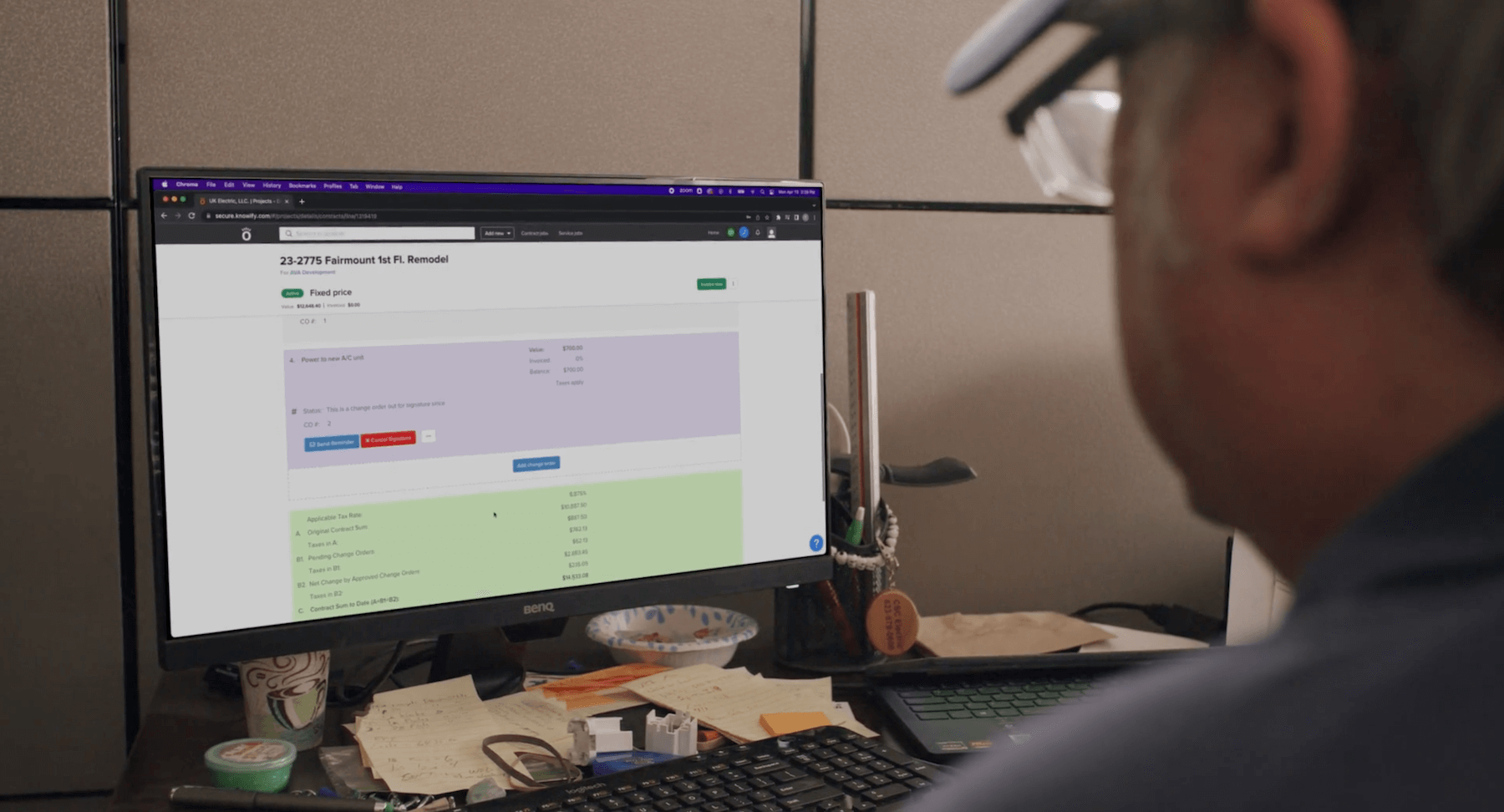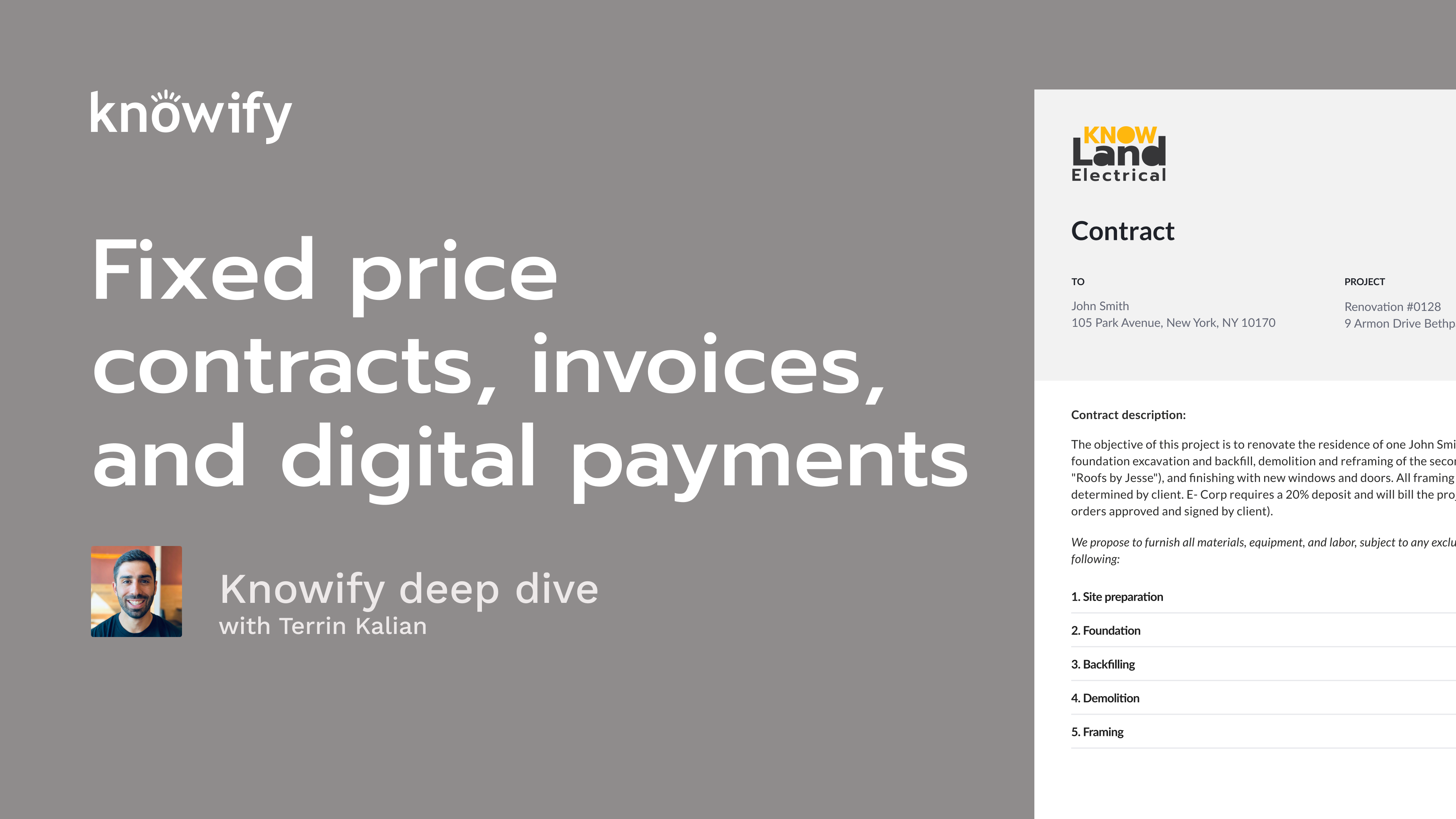Construction accounting is unique from any other industry. It requires specialized skills and knowledge that traditional accounting rarely dips into such as work-in-progress (WIP) and retainage. The key difference, however, is that construction accounting requires you to track the financial performance of many distinct jobs at once. Construction accounting methods often involve long-term contracts invoiced on a percentage of completion basis (another concept rarely seen outside of construction—more on this later).
Project-based accounting is the technical term for the style of accounting used in construction. It treats each construction project independently, complete with a budget, as well as detailed revenue and expense tracking. In order to do this well, you and your accountant must be meticulous when it comes to revenue recognition and expense tracking on a per project basis.
Below we’ll take a look at the four most common methods in construction accounting. We’ll start with a breakdown of cash basis vs. accrual accounting before looking toward the more specialized revenue recognition methods known as percentage of completion and completed contract.
While we always recommend that you work with an accountant, it’s crucial that you have a firm grasp of these accounting methods yourself. This will allow you to better work with your accountant to understand why your business performs as it does. The more knowledge you have on these concepts the more empowered you’ll be to make informed financial decisions for your business.
What are the two fundamental accounting methods?
There are two fundamental accounting methods used in the construction industry:
- Cash basis accounting
- Accrual accounting
- Percentage of competition (revenue recognition method)
- Completed contract method (revenue recognition method)
- Cash basis: One of two core accounting methods, this method will see revenue and expenses recognized as soon as they are received or paid. It’s cash-in/cash-out accounting. When money hits your account, you record it. When money leaves your account, you record it.
Accrual accounting: The second core method of accounting, accrual accounting, recognizes transactions when they are earned or promised, regardless of when money actually switches hands.
Percentage of completion: Using the principles of accrual accounting, percentage of completion is a revenue recognition method whereby you’ll recognize costs and revenues based on how far along you are on the job–when the project is 20% done, you bill for 20% of the contract value.
Completed contract method: Under this revenue recognition method, you won’t recognize revenue or expenses until the construction project reaches substantial completion. Because this method relies on the “matching principle” (more on this later), it too falls under accrual accounting.
Below, we’ll break down each of these methods taking a deeper look at how they operate in a construction or specialty trade setting.
Cash basis of accounting
Cash basis accounting recognizes transactions at the time they occur. As soon as you pay or receive money, your books will change to reflect those interactions. Interesting to note: this method doesn’t include accounts receivable or accounts payable.
In effect, unpaid bills or future payments are only recognized when those funds physically transfer hands. For example, imagine you receive a check at the end of the year. But you don’t deposit it until the following year. Under cash basis accounting, you’ll have to report that income in the earlier year to reflect when that transaction took place.
What is an example of the cash basis method in use?
Let’s say a contractor wins a job to build a fence around a property. All the materials needed cost $1,000, and the total contract amount will award you $2,000.
You now have two big transactions to record:
1) You must record the $1,000 in material expenses as soon as you make those purchases
2) You must record the $2,000 in revenue as soon as the property owner pays you the full contract amount
Let’s assume you pay for all the materials, build the fence, and receive payment in cash, all within the same day. Under cash basis accounting, you will record the $2,000 in revenue and $1,000 in expenses for this job on the same day.
Now, what if the property owner wasn’t able to pay you until the following week? In this scenario, you would record the $1,000 of expenses on the day you incurred them. And record the $2,000 in revenue the following week when payment is finally received.
Pros and cons of cash basis accounting
First, it’s a great way to record transactions for small businesses that mainly deal with and operate in cash. It’s simple and easy to understand. You don’t necessarily need to implement extensive accounting practices or bring on financial experts to get by.
But don’t get too excited because not everyone can take advantage of cash basis. One of the cons comes in the form of legal thresholds. The IRS makes it clear. If you made $26 million or less over the last three tax years, you’re eligible to use cash basis. If you exceed this threshold, you’re forbidden from it.
But even if you fall under this threshold, most trades are far too complex to get by using the cash basis method. Cash basis makes it virtually impossible to analyze profitability over a particular point in time.
Let’s say you wanted to analyze how profitable you were in July of last year (during your busiest time of the year). There will be a timing difference between revenue and expense recognition using cash basis. You may not get paid for all completed work in July until August or even September. In this case, September will look like your most profitable month when in reality, you earned this money in July.
In short, when you rely on cash basis accounting, you won’t have an accurate way to record profits. This will bring huge fluctuations in results that can make it difficult to accurately job cost. Why? Because you’ll be recording income and expenses in separate accounting periods, making it extremely challenging to understand your true financial position. Finally, the cash basis of accounting isn’t allowed under GAAP or IFRS (more on this in the next section).
So is it okay to use cash basis accounting? Generally, yes, but it depends. You must fall under the IRS threshold and have the understanding that you’ll eventually need to replace this method with something more robust as your business grows. If you meet these criteria, the cash basis method can be a great jumping-off point as you ramp up your business.
Need a better handle on your construction accounting? See how Knowify’s best-in-class QuickBooks integration can make your life easier
What is accrual basis accounting?
Under accrual accounting, you’ll recognize revenue as it’s earned and expenses when they are incurred. You’re recognizing any money you expect to receive or pay without waiting for money to trade hands. What this does is match revenue and expenses to the same period. This way, you can better extrapolate performance from month to month and from job to job.
For example, let’s say you won a contract to build a fence with a total contract price of $5,000 with net-60 payment terms. If you complete the fence in July, you’ll record $5,000 in revenue in July because that’s when you earned that revenue. Even if you receive payment 30 days later in August, you’ll still record the revenue from this job in July to reflect when you physically built the fence and earned payment. The same rule applies to expenses. If you incurred costs in July, you’ll recognize them in July (whether you actually received the materials or not).
In other words, you can acknowledge that you’ll pay this money later, but you can account for it right away.
Along these lines, you can now match revenues to the expenditures that help you generate those revenues, giving you a more accurate picture of the true results of this job. You’ll hear this concept referred to as the “matching principle.” This principle solves the biggest problem from cash basis accounting, which is the misalignment of revenues and expenses. In doing so, it can also help you gain powerful insights into the profitability and financial health of your business.
Pros and cons of accrual basis accounting
Because accrual accounting lets you recognize revenue and expenses in the same accounting period, it’s one of the best ways for a construction company to understand its true financial position. This is huge for job costing since you can look at the true profitability of a specific time period and project.
With this information, you can pinpoint cost overruns with much more accuracy. You can even look into macro trends like the seasonality of your business.
However, there is one big caveat. The accrual method does not explicitly track cash flow. So you’ll need to find a strategic way to separately handle cash flow tracking.
Another thing to remember is that accrual requires a lot more work than cash basis. Accrual accounting requires careful tracking of accounts payable, receivables, and concepts like deferred revenue and payroll accrual. Unless you were a CPA in a past life, this means you need to hire an accountant to manage this for you.
Additionally, it relies on estimates and assumptions on payment. You must trust that vendors, suppliers, general contractors, and project owners will pay their debts on time and in full. This can make it unsuitable for small or young businesses that face a lot of uncertainty.
What is GAAP?
We’ve mentioned GAAP and its importance a few times now, but what exactly is GAAP? Generally Accepted Accounting Principles, or GAAP, detail standardized accounting guidelines created by the Financial Accounting Standards Board. They serve as the single source of truth for all financial statements in the U.S.
Virtually every public company follows GAAP, including most construction companies, contracting businesses, or independent contractors that release financial statements. When it comes to recognizing revenue, classifying expenses, or reporting results, accountants rely on GAAP.
The biggest reason GAAP doesn’t allow cash basis accounting is inaccuracy. Since cash basis records income and expenses in different periods, it opens the door for mistakes. It does this by distorting the true financial position of a company. Instead, GAAP requires accrual accounting, as it does a better job of accounting for a company’s genuine financial standing.
In addition, one of the main functions of GAAP is to create a level playing field for auditors or lenders looking to compare financial results against benchmarks. If you ever need a loan, these lenders will want to see your GAAP-compliant financial statements. If you’re using cash basis accounting, this obviously presents a problem. For this reason, the accrual method is the preferred choice for construction (along with many other industries).
Yes, GAAP is accrual counting. You must use a revenue recognition method that falls under accrual accounting to remain GAAP compliant. For this reason, any time you need to produce financial statements, you should do it through an accrual GAAP-based format.
Additionally, if and when you need to secure funding, you should bank on investors asking to see your GAAP-based financials.
What is the difference between cash accounting and accrual accounting?
Accounting method Revenue Expenses
Accrual-based accounting Recorded when earned Recorded when incurred
Cash-based accounting Recorded when money is received Recorded when money is spent
The biggest difference lies in recognition. Under cash basis, you’ll record transactions when money is physically exchanged. While under accrual, you’ll recognize money when it’s earned or owed.
Deciding which method to choose depends on the size and complexity of your business. Cash and accrual accounting are both acceptable options for tax purposes; remember that for cash basis, you must pass the gross receipts test per the IRS.
Most trade contractors can choose to get by with the cash basis of accounting. It’s relatively easy to implement and gets the ball rolling with tracking cash flow.
However, as your business scales in size and takes on bigger, more complex jobs, the cash basis of accounting just won’t be viable or permitted by government organizations.
In addition, the following business structures can’t use the cash method:
Corporations (Other than an S-corp)
A partnership with a corporation
We recommend avoiding the cash method if possible. It won’t set your company up for long-term growth and will limit the amount of actionable information you can gain from your financial data.
In any case, always seek the advice of a financial expert who can give you the advice and guidance you need to make the right decision for your business.
Percentage of completion method
Percentage of completion (POC), also known as progress billing, is the bread and butter revenue recognition method for long-term construction projects. Under percentage of completion, revenues and expenses depend on the percent of work completed. In other words, you’ll recognize revenues and associated costs based on how far along you are on the job.
The percentage of completion method requires the use of progress invoices–a billing document used to bill for partial project completion as you complete work. An example of which is the AIA-style payment applications. These detailed payment invoices incorporate work-in-progress reporting to provide an organized summary of all project tasks, costs, equipment, and retainage information for a particular payment period.
They are then used to assess progress and determine all subsequent payments matching the completed work.
Along these same lines, work-in-progress reporting, or WIP will determine the value of the work that you have completed but have not yet invoiced. This will help you understand if you are over or underbilling as a project progresses.
While accounting software manages most of the heavy lifting here, the formula below breaks down how you can calculate and recognize revenue using the percentage of completion method:
Revenue = (% of work completed in a period of time) * Total contract value
What is an example of the percentage of completion method?
Typically you’ll send invoices periodically reflecting the percentage of work completed. That revenue is then recognized when invoiced. From there, you can identify and recognize all associated costs. For example, you may quote a job for $150,000, with billing based on the percent of completion at the end of each month. At the end of the first month, with 10% of the project completed, you’ll send an invoice reflecting 10% of the total ($15,000).
For another example, we imagine a contract with a total value of $1,000,000, which spans a three year period. Using the following calculations, you can determine revenue to date, cost to date, and the percent of completion at the end of each year.
Calculations:
Revenue to date = % complete * contract price
Cost to date = Cost to date from previous year + Costs incurred in current period
% complete = Cost to date / Total estimated costs
Contract year 2023 2024 2025
Contract price $1,000,000 $1,000,000 $1,000,000
Costs incurred in current period $258,000 $220,000 $170,000
Cost to date $258,000 $478,000 $648,000
Estimated costs yet to be incurred $400,000 $190,000 $0
Total estimated costs $658,000 $668,000 $648,000
% complete 39% 71.50% 100%
Revenue to date $392,097 $715,000 $1,000,000
This example is only scratching the surface. There is much more to understand especially concerning complex and multi-year projects that require meticulous handling of revenue recognition. Fortunately, Knowify has you covered. Check out the following guide to learn everything a contractor needs to know about the percentage of completion method.
Another variation of the percentage of completion method is milestone billing–when you hit a specific milestone, you’ll create and send an invoice to bill for all work completed up to that milestone.
Pros and cons of percentage of completion method?
One of the most significant advantages of percentage of completion is that you can get a view on profitability before the job is complete. Another benefit is that you don’t have to wait until the end of a project to receive payment. Additionally, you can avoid a heavy cost hit at the start of the job since you won’t need to front the entire project as you’ll be receiving payment along the way as you progress through the job. This can be a game-changer for cash flow management. If you can handle your cash flow tactfully, you can keep dollars flowing in without waiting for everything to wrap up.
Another perk of POC is that it gives you a clear snapshot of job progress. You can see how much of the project you’ve completed at any given time. Allowing you to track progress and make any necessary adjustments. This can improve communication with project owners, GCs, and other stakeholders. It provides an opportunity to slow down and check your work. This is an opportunity you should always seize. It’s like having a trusty GPS system guiding you through the project–you’ll always know where you stand.
However, one of the main drawbacks of POC is that it relies heavily on estimates. You’ve got to have a solid system in place for estimating profitability, job costs, and progress. In other words, it’s all about predicting the future as accurately as possible. If you don’t have a precise system, your numbers can be drastically off, creating inaccuracies in all subsequent estimates.
Is percentage of completion required for GAAP?
GAAP requires you to recognize revenue in the period you earned it. Since percentage of completion follows the principles of accrual accounting, it satisfies this requirement.
If you wish to stay GAAP compliant, there are many revenue recognition methods to choose from: installment method, cash recovery, consumption method, percentage of completion, and completed contract. As you can see, percentage of completion is not the only GAAP compliant method that utilizes accrual accounting.
However, in a construction setting, the percentage of completion method will serve as your best bet for staying GAAP compliant when accounting for long-term projects.
Completed contract method
The completed contract method has a similar setup to the percentage of completion method. However, it’s best used for small jobs that are relatively short-term or when a project brings an inherent risk to job completion beyond what is typical. For example, situations where political instability or natural disasters may interfere with project completion. For this reason, the completed contract method can be a tool for hedging against unpredictable circumstances.
As the name implies, this method recognizes revenue only after you’ve completed the contract (or reached substantial completion). In practice, this means you won’t record any expenses or revenues as the project progresses, even if you buy materials or receive compensation from the project owner.
What is an example of a completed contract method?
Suppose you win a contract to construct a new barn over six months. Over the following months, you’ll buy materials, schedule and pay your crew, and deal with suppliers. You may even receive partial payment or reimbursement for parts of the project.
How then, will you recognize all these transactions? You’ll accumulate all billing and related costs in a balance sheet using a percentage of completion or construction in progress account.
But still, you won’t be officially recognizing them. Instead, you’ll wait until the end of the six months as soon as you complete the contract. Only upon substantial completion will you recognize the revenue and expenses from this project.
Pros and cons of completed contract method?
As mentioned, the completed contract method is somewhat similar to the percentage of completion method, but it’s a very simplified version that requires much less admin work. This is because there is no need to track and calculate payments and match them to work completed. Instead, you’ll wait until you hit substantial completion and then recognize everything all at once.
The advantages of this, are its simplicity and potentially advantageous tax treatment since you’ll be paying your taxes later as compared to other methods. Under the completed contract method, contractors can defer taxes until the ongoing project is contractually complete.
In addition, there is no spacing of revenues or gross profits. This creates a distortion of earnings that is lopsided to the end of a project. For this reason, you should only consider it for situations where you can’t figure out job progress in a logical way (i.e., there are no reliable milestones to base payments around).
Overall, it’s not a method that you should rely on as your first choice. There isn’t any particular advantage to using it long-term that we can point to from a contractor’s perspective.
Does the completed contract method comply with GAAP?
It depends. The completed contract method is only GAAP compliant under certain circumstances. The most significant sticking point with GAAP is you always recognize revenue and expenses in the same accounting period. If the specifics of your contract allow you to do so, then the completed contract method is technically plausible.
However, this is a slippery slope, and you should consult with your accountant before moving forward with this method. The percentage of completion method is a better choice for most long-term projects.
How to choose the right method for your business
Choosing the right method for your company will come down to the following:
Size of your company
The goals of your company
The types of contracts you work with
Local laws and regulations
Whether or not you have an accountant
In the construction industry, your best bet is to use percentage of completion. While there are exceptions where cash basis is okay, accrual is a reliable option for companies of any size. Similarly, percentage of completion is always a trustworthy option for long-term projects.
Remember that you must pass the gross receipts test to use cash basis or completed contract methods. So if you’re a large company or growing business with your sights set on growing even more, we suggest you steer clear of cash basis accounting. It won’t give you the tools you need to manage your business in a way that facilitates long-term growth. When in doubt, work with a certified professional accountant to set up the accounting system that will work best for your business.
Experience the power of a digital future for your business. Take the next step and schedule a 1-on-1 demo with a Knowify expert today and gain the key to a paperless and efficient workflow.
Build your business with confidence with organized projects that stay on-budget
Meet a Knowify expert on a video screenshare, get your questions answered, and ensure you’re set up for organized, profitable projects with Knowify.
Schedule Demo
 QuickBooks
PricingTraining & support
QuickBooks
PricingTraining & support



